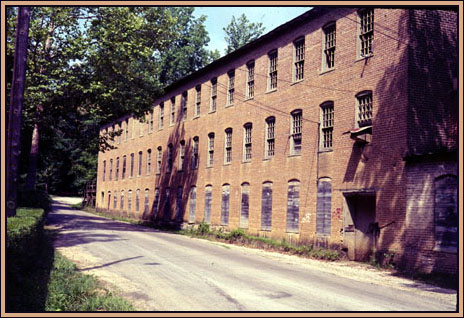
Great Falls Cotton Mills
Great Falls Cotton Mill was envisioned by early manufacturer, Asa Faulkner, and
was built by the Great Falls Manufacturing Company that was chartered by Asa
Faulkner, Jesse and H. L. Walling, and Clay Faulkner. The only textile mill built in
Warren County before 1930, it is also known as Fall City Cotton Mills and is located in
Northern Warren County within present-day Rock Island State Park. It began operation
in 1892, and was best known for heavy sheeting. The wheel house which powered the
mill was swept away in the great flood of March 1902, that wrought havoc
throughout the county. It never resumed operation, but it is listed a s a National
Historic Site.
Source of the above info is THE WARREN COUNTY STORY by
Eugene Wiseman
Falls City Cotton Mills
This mill, sometimes referred to as the Great Falls Cotton Mill, was located at the
Great Falls of the Caney Fork River. Heavy cotton sheeting was the best known
product. The original wood block use to stamp the sheeting, using powdered bluing,
was found in a trash heap under the mill about 1928 and was given to the McMinnville
Public Library.
Part of the flowing water of the Caney Fork was diverted towards the river bank
and into a channel behind the stone wall. The water then flowed in to the wood flume
which carried it into a recess cut in the bluff. It then flowed into the water chamber in
which a turbine was mounted. The turbine shaft extended up into the horizontal shed
above. A rope pulley connected the turbine shaft with another under the sloping roof.
Again a rope belt was used to connect with the main drive shaft in the mill. Power was
transferred to various parts of the building with belts and shafts.
Fall City Post Office was located in one of the buildings to the east of the
Mill.
Asa Faulkner purchased the property formerly belonging to the Cunningham
family in 1881. This included most of the land between the Caney Fork and Collins
River. In 1883 he bought a one-half interest in the Bosson property across the Caney
Fork. He, together with Clay Faulkner, Jess Walling and H.L. Walling had a wheel pit
dug and a low diversion dam built at the Falls. James McGiboney installed a saw mill
and grist mill for the owners and was employed to operate it. The owners erected a
timber bridge across the mouth of Collins River and a log toll house on the hill above
the saw mill. Later a frame house was erected on the river side of the road closer to the
bridge. This building was used as a construction office during the building of the power
dam. It was torn down in 1927. Mr. McGiboney sawed out all the timbers and lumber
for the bridge and houses.
A small community grew up in the area and was called "Falls City." The spring of
1892 saw the first real boom for Falls City. The Falls City Cotton Mill Company was
chartered with a capital of $30,000 to "manufacture, spin, weave, bleach, dye, print,
finish and sell all goods of every kind made of wool and cotton." A three story brick
mill was erected by the company. The brick were burned on the hill and a short distance
upstream from the mill. The company also purchased the toll-bridge from Asa
Faulkner.
The Mill was known for its' "heavy sheeting". There was a post office, store, and
other structures at Falls City, although all are gone. The mill furnished employment to
citizens of the neighborhood and the little community thrived and grew. Then came
that memorable Good Friday in March of 1902 when the heavens opened up, and rain
came down in torrents. The mighty Caney Fork, like a dog which had been straining at
its' leash, suddenly broke loose. The raging torrent sweeping down off the mountains
carrying death and destruction before it swept away the wheel house and the Collins
River bridge as well as every other mill on the river. The old river had gained one more
victory over man thus ending a chapter in the development of power at Great Falls.
Easter Sunday in 1902 was a lovely clear day; but for the citizens of Falls City things
looked very gloomy even though they knew in their hearts that the old river would
some day be conquered.
from: THE CANEY FORK OF THE CUMBERLAND by Arthur Weir Couch,
1973.
Photograph & Page Compilation by Jane Hembree Crowley
More Great Falls photos

